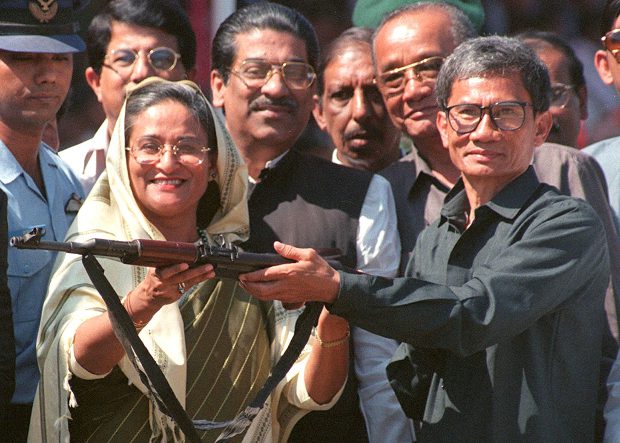Three decades after the signing of the peace accord, lasting peace in the Chittagong Hill Tracts remains elusive. Tensions are once again rising in the region as armed activities by two major ethnic groups—the United People’s Democratic Front (UPDF) and the Kuki-Chin National Front (KNF)—have recently intensified. Against this backdrop, the sudden visit of former guerrilla leader and current Chairman of the CHT Regional Council, Jyotirindra Bodhipriya (Santu) Larma, to India has sparked further speculation.
A leader of the Parbatya Chattagram Jana Sanghati Samiti (PCJSS) told Times of Bangladesh that Larma is on a 29-day official leave for personal and medical reasons and will spend most of this time in India.
According to government sources, Larma crossed into Agartala, Tripura through the Akhaura International Immigration Checkpost on May 3. Besides undergoing medical check-ups, he is scheduled to take part in religious rituals and ceremonies for ancestral offerings.
However, intelligence agencies suspect the trip is not entirely personal.
From Agartala, Larma is expected to travel to Kolkata and New Delhi. Though he has visited Kolkata before—where his daughter Juliana Larma and her husband, former Shanti Bahini member Prodhir Talukder, live—this is the first time in 27 years that he has travelled to India via land route, rather than his usual Dhaka-Kolkata or Chattogram-Kolkata flights. This unusual change has drawn attention.
Coincidentally, key UPDF leaders, including its President Prasit Bikash Khisha and general secretary Rabishankar Chakma, are also currently in Tripura. Once comrades of Larma in the Hill Students Council (PCP), they have since been in political conflict with Larma’s PCJSS over the peace accord. Violent clashes between the two groups over the years have claimed over a thousand lives. While there have been occasional reconciliations, tensions persist.

Security analysts are now raising questions: Are these factions once again entering a phase of covert coordination? Intelligence sources are actively investigating this possibility.
Experts warn that if a new wave of militancy emerges in the hills amidst shifting national and regional geopolitics following the political transition on August 5, the situation could spiral out of control.
Sources in the Hill Tracts say at least five armed groups are currently active: UPDF (Prasit), UPDF (Reformist), JSS (Santu), JSS (Larma), and the KNF led by Nathan Bom.
While allegations persist that UPDF has received arms and training from Tripura and Mizoram, the group has consistently denied engaging in armed activity.
KNF, although banned about a year ago, continues to openly promote the idea of an independent Kuki state through Facebook and YouTube, claiming parts of Bandarban and Mizoram. Their presence diminished somewhat after a bank robbery in Ruma last year and a subsequent crackdown, with many members reportedly fleeing across the border into Mizoram.
According to intelligence, some Indian regional outfits, Naga and Mizo separatist groups, and certain questionable NGOs are suspected of indirectly supporting these factions. There is also growing concern over possible tactical alliances with rebel groups in Myanmar.
Retired Major General Dr. Monirul Islam Akhand told Times of Bangladesh that although the Arakan Army (AA) is fighting Myanmar, it has longstanding arrangements with hill groups in Bangladesh regarding arms exchanges and joint camp maintenance.
He warned that intensified cross-border collaboration could lead to a major conflict along the frontier.
Security analyst and North South University faculty member M.A. Rob added, “Separatists are always active in border crossings. There is credible information about their regular movements to Mizoram.”
According to several ISPR statements, joint special operations by Bangladeshi security forces are currently underway in the hill border regions. Over the past two months, large caches of weapons have been seized and multiple suspects have been detained.
Meanwhile, the U.S. government has advised its citizens not to travel to the Chittagong Hill Tracts. This foreign advisory is seen as both a reflection of the area’s fragile security situation and a sign of growing international scrutiny.


